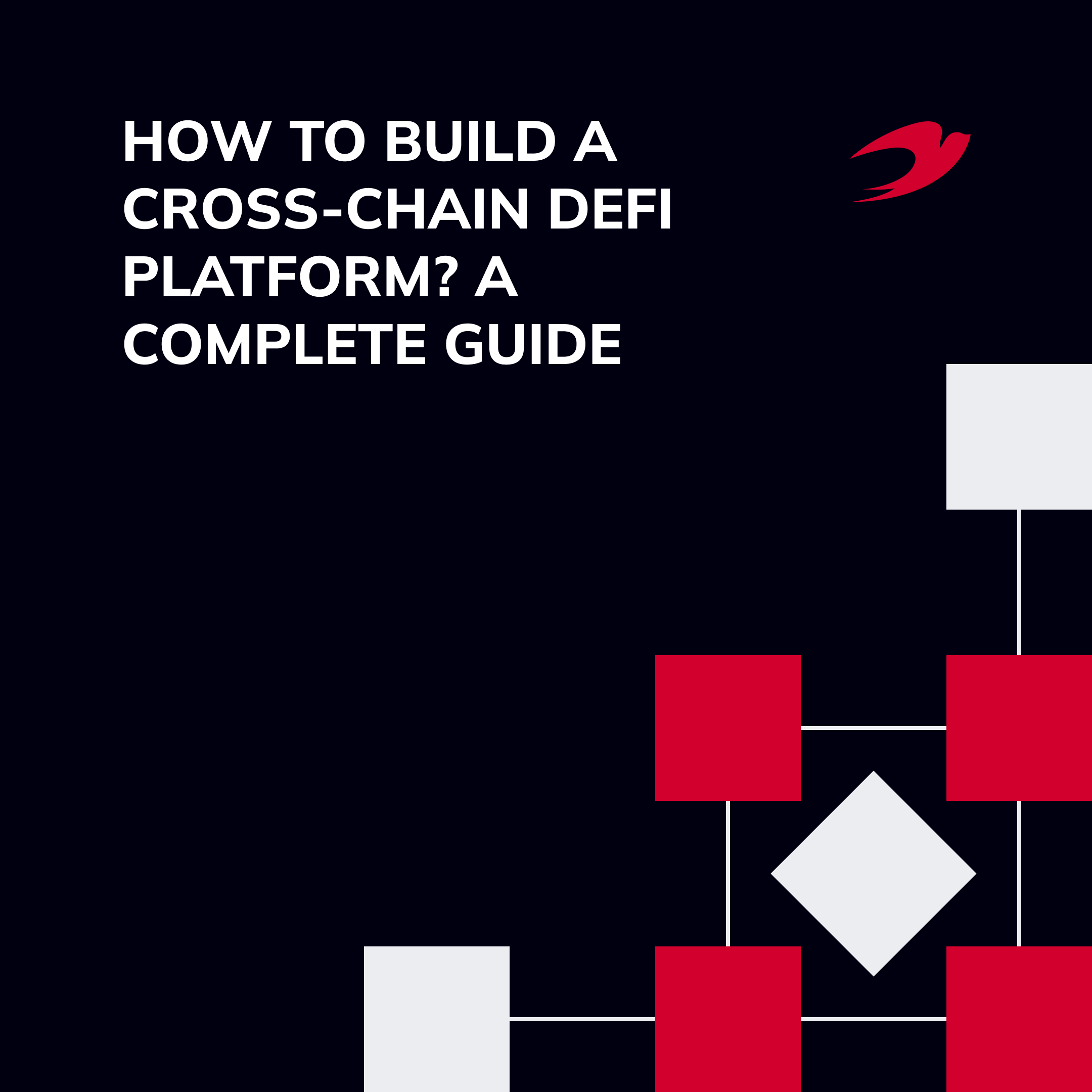The Web3 ecosystem is becoming more extensive with each passing year. Thousands of dApps run on blockchains and Layer 2 (L2) solutions. However, these disparate networks are not able to communicate effectively with each other. Cross-chain in crypto solves this problem and allows assets to be transferred from one blockchain to another. It stimulates ecosystems to engage with each other and think of launching a cross-chain DeFi platform. Today, we discuss how to develop cross-chain DeFi platform and what features it must have.
What are the key advantages of using a cross-chain DeFi platform over a single-chain platform?
One of the main advantages is more straightforward interoperability across different DeFi protocols, which allows for seamless trading, lending, and exchanging of assets. Another advantage is moving collateralized digital assets from the classic chains blockchain to modern ecosystems such as Kadena, Stllar, Cardano, Solana, or layer-2 solutions. Other advantages include improved scalability, liquidity increasement, and better storage capacity.
Considering building a cross-chain solution or develop bridge for your current DeFi platform? Let’s talk and define the specification for your project together!
Table of Contents:
- What Is a Cross-chain DeFi Platform?
- Core Components of a Cross-Chain DeFi Platform
- Cross Chain Defi Platform Development Process: X Main Stages
- Summary
What Is a Cross-chain DeFi Platform?
Cross-chain DeFi combines numbers of financial applications that exists through various blockchain ecosystems. It is leveraged by cross-chain technology that enables the seamless transfer of data and tokens across various blockchains. This interoperability is facilitated by cross-chain bridges, acting as gateways for token exchanges among multiple chains.
What Is a Cross-chain Bridge?
A cross-chain bridge is a decentralized protocol designed to transfer assets and information between blockchains. Such solutions can send tokens of almost any kind, including NFTs.
What to Consider Before Building Cross-Chain DeFi Platform
The demand for interoperability between blockchains has become increasingly evident. However, before diving headfirst into building cross-chain DeFi platform, there are several crucial points you should keep top of mind.
Market Need
The fundamental driver behind any successful project is fulfilling a market need. In the context of cross-chain DeFi platforms, the need is evident. With the increasing complexity of blockchain ecosystems and liquidity fragmentation across different networks, users seek seamless interoperability solutions. Here are the main points that drive popular DeFi projects to think about cross-chain features:
- encourage an exchange of liquidity between blockchains
- encourage an exchange of users
- faster adoption of new technologies
- faster knowledge-sharing among crypto-experts
- encourage competition in the DeFi space.
In the current market situation, the DeFi project must consider cross-chain opportunities to be competitive. Now, almost everything is cross-chain, and nobody wants to use only one blockchain with tokens that nobody needs except for that network. This is why cross-chain peculiarity is among Web3.0 trends.
Technical Considerations
Developing a cross-chain DeFi platform involves navigating technical challenges. Interoperability protocols, smart contract development, and cross-chain bridge development are just a few of the technical considerations. They require meticulous planning and execution. You must:
- Choose the right blockchain infrastructure
- Implement secure cross-chain communication protocols
- Ensure scalability
With these points in mind, your cross-chain DeFi project will gain long-term viability and success.
Regulatory and Legal Landscape
The regulatory and legal landscape surrounding DeFi is still evolving. Operating in multiple jurisdictions adds another layer of complexity.
Before building a cross-chain DeFi platform, you must examine the country’s legal framework. If you want to build a DeFi project for the USA market, you must ensure that the chosen country of registration allows that. We at IdeaSoft specialize in such issues and can select a variant that will consider all the legal nuances for you.
Our portfolio has a demonstrative example of compliance with legal requirements. When we worked on Securitize, our team had 10-12 engineers. At the same time, we had a team of 20-25 lawyers from a specialized New York law firm who monitored and helped to describe the project documentation and the legal part. They also worked on the legalization of all processes.
Herman Stohniiev, CTO and Co-founder of IdeaSoft
Business Considerations
Creating a cross-chain DeFi platform is not only a technical endeavor but also a business venture that requires careful planning and resource allocation. You must consider factors such as project duration, cross-chain DeFi platform development cost, and ongoing maintenance expenses.
To start DeFi project in any direction, we recommend assessing the competitive landscape and identifying unique value propositions. This will help position the platform for success in a crowded market. By the way, we at IdeaSoft have 7+ years of experience creating Web3 projects and can help you assess the current market. Feel free to contact us for initial consultation with our tech specialist.
Core Components of a Cross-Chain DeFi Platform
Certain core components are indispensable for building a robust cross-chain DeFi platform. Here are the necessary features to develop cross-chain DeFi platform.
Smart Contracts
Smart contracts serve as the backbone of any DeFi platform. They automate transaction execution and enable trustless interactions between users. In terms of a cross-chain DeFi platform, smart contracts facilitate interoperability between disparate blockchains. This is achieved thanks to executing cross-chain transactions securely and efficiently.
Cross-Chain Bridge Integration
Cross-chain bridge integration is needed for the transfer of assets and data between different blockchains. These bridges act as interoperability protocols. They allow users to seamlessly move assets from one blockchain to another while maintaining security and trust.
Liquidity Management
You must think through effective liquidity management to build cross-chain DeFi platform. Liquidity is paramount for the smooth functioning of any DeFi project. However, managing liquidity across multiple blockchains presents unique challenges. And you must think of them in advance.
Nevertheless, implementing sophisticated liquidity management strategies can optimize liquidity provision. These can be automated market-making algorithms and liquidity pools. This point is also important for ensuring efficient asset exchange across diverse blockchains.
Security Measures
Security is paramount as the threat landscape is constantly evolving. Implementing robust security measures, including encryption protocols, multi-signature authentication, and audit trails, is essential for safeguarding user funds and data in a cross-chain DeFi environment. Additionally, conducting regular security audits and vulnerability assessments can help identify and mitigate potential security risks proactively.
User Interface (UI) and User Experience (UX) Design
UI and UX design shape the overall usability of your cross-chain DeFi platform. A well-designed UI/UX enhances user engagement, fosters trust, and simplifies complex processes such as asset exchange and liquidity provision. You should:
- Prioritize intuitive navigation
- Utilize responsive design
- Provide seamless integration with blockchain wallets
This way, you can enhance the user experience and drive the adoption of your Web3 platform.
Cross Chain Defi Platform Development Process: X Main Stages
Here are the main steps of cross-chain DeFi platform development:
- Define goals and functionality. The first step is to clearly define the goals of your cross-chain DeFi project and the required functionality. You must understand how your Web3 project will stand out in the market.
- Market research. Conduct a thorough DeFi market research, study your competitors, and identify the advantages and disadvantages of existing cross-chain solutions. Identify potential gaps in the market that your Web3 project can successfully fill.
- Select a blockchain platform. Choose the right blockchain platform to develop your DeFi app.
- Develop cross-chain bridge. Deploy bridge smart contracts on both blockchains along with handler contracts. Then, an Oracle system can be deployed and integrated with bridge contracts.
- Create smart contracts. Develop secure and efficient smart contracts that will fulfill your app’s core functions. Provide facilities for liquidity, token management, and other decentralized financial transactions.
- Design the user interface. Create an intuitive and user-friendly UI. It is important that users can easily interact with your cross-chain platform even if they do not have technical skills.
- Test and optimize. Conduct thorough testing of your DeFi application, including functional, security, and performance testing. Based on the test results, optimize the code and functionality.
By following these steps and paying attention to each step, you can increase your chances of building a successful and competitive DeFi cross-chain app.
Summary
Creating a cross-chain DeFi application is a complex and time-consuming process. It requires careful planning, an understanding of complex financial processes, technical skills, and strategic thinking. However, by following the steps outlined above, you will be able to develop a successful and competitive cross-chain DeFi app that can attract the attention and trust of users.
Want to create your own blockchain solution? Contact our IdeaSoft team. Our team of experts is ready to provide you with high-quality cross-chain DeFi application development services right now.




